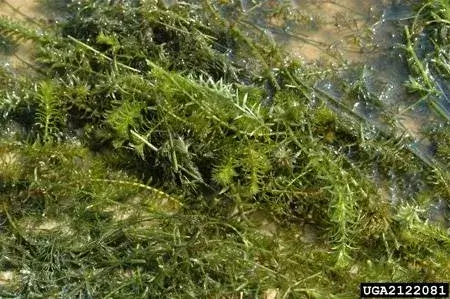
Hydrilla (Hydrilla verticillata), also commonly called water thyme, is a submersed perennial herb. The plant is rooted in the bed of the waterbody and has long stems (up to 25 feet in length) that branch at the surface where growth becomes horizontal and forms dense mats. Small (2 – 4 mm wide, 6 – 20 mm long), pointed, often serrated leaves are arranged around the stem in whorls of 3 to 10. Southern populations are predominantly dioecious female (plants having only female flowers) that overwinter as perennials. Populations north of South Carolina, including populations in New York, are essentially monoecious (having both male and female flowers on the same plant) that set some fertile seed, and depend on tubers for overwintering. These monoecious plants produce female flowers with three translucent petals 10 – 50 mm long by 4 – 8 mm wide, and male flowers with three white to red narrow petals about 2 mm long.

The dioecious form of Hydrilla is believed to originate from the Indian subcontinent, specifically the island of Sri Lanka, although random DNA analysis also indicates India’s southern mainland as a possible source location. The monoecious form is believed to have arrived on our shores from Korea.

The dioecious strain of H. verticillata was imported as an aquarium plant in the early 1950s. Discarded (or intentionally planted ) colonies were found in canals in Miami and Tampa shortly after. The monoecious strain was introduced separately decades later in the Potomac Basin.
Both dioecious and monoecious Hydrilla propagate primarily by stem fragments, although turions (buds) and subterranean tubers also play an important role. The main means of introduction of Hydrilla is as castaway fragments on recreational boats and trailers and in their live wells. New colonies can often be found near boat ramps as such stem pieces become rooted in the substrate (even very, very small fragments can become the start of new populations). Boat traffic through established populations can shatter and spread Hydrilla throughout the waterbody, similar to the spread of Eurasian watermilfoil.
Hydrilla is often a contaminant on popular watergarden plants and may be unwittingly transported and established in private ponds in this manner. As with most invasive aquatic plant species, Hydrilla is a very opportunistic organism and can often be found taking over waters that have had populations of Eurasian watermilfoil chemically removed without a management plan for reestablishing native vegetation.

Hydrilla can invade deep, dark waters where most native plants cannot grow. The plant’s aggressive growth (hydrilla’s 20 – 30 foot stems can add up to an inch per day) can spread into shallow water areas and form thick mats that block sunlight to native plants below, effectively displacing the native vegetation of a waterbody. Major colonies of hydrilla can alter the physical and chemical characteristics of lakes:
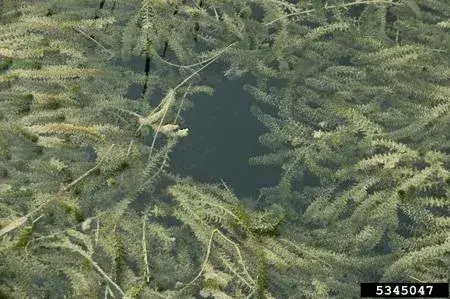

Hydrilla has pointed, bright green leaves about 5/8 inches long. The leaves grow in whorls of 3 – 10 along the stem, 5 being most common. The margins of the leaves are serrated (toothed). Thin stalks from the stem end in a single, small, floating white flower at the water’s surface. A key identifying feature is the presence of small (up to half inch long), dull-white to yellowish, potato-like tubers which grow 2 to 12 inches below the surface of the sediment at the ends of underground stems. These tubers form at the end of the growing season and serve to store food to allow Hydrilla to overwinter.
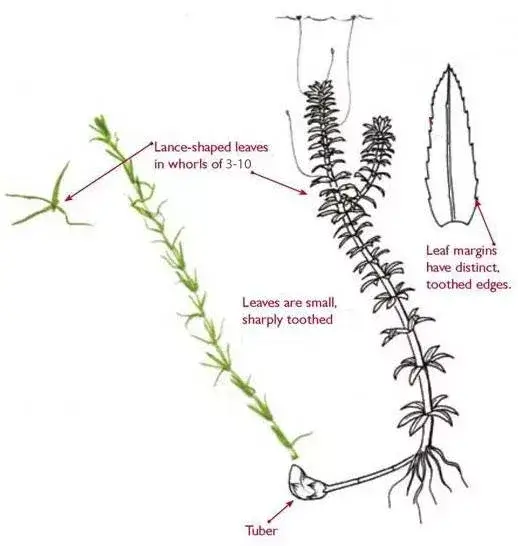
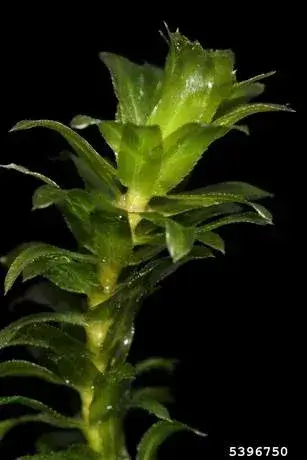
Hydrilla is often confused with the common native water weed, Elodea Canadensis, which has whorls of 3 smooth-edged leaves as opposed to whorls of 4 to 10 serrated and spined leaves.


Line art: University of Florida Center for Aquatic Plants

The best way to help prevent the spread of Hydrilla is to follow basic clean boating techniques:
For All Types of Watercraft:
For Non-Motorized Craft Such as rowing shells, canoes, kayaks, and sailboards:
Open airlocks on shells or air bladders on kayaks after use and allow to dry thoroughly, as plant fragments can survive moist conditions for many days
Around Docks, Launch Sites, and Other Areas:
If plant fragments are piling up around dock areas, use a rake to remove plant material and dispose in the trash

Mechanical harvesting and herbicide spraying are common control methods of controlling Hydrilla. Both are expensive and only moderately effective.
Waterbodies infested with Hydrilla can be found in 70% of Florida’s freshwater drainage basins, making it the most abundant aquatic plant in that state’s waters. Hydrilla is also widespread throughout Alabama; impoundments on the Tennessee River; eastern Mississippi; southeastern Tennessee; southwestern Georgia; South Carolina; eastern North Carolina; in Virginia’s Potomac, Rappahannock, and Appomattox Rivers and into the piedmont, in the tidal freshwater reaches of the Potomac River on the Virginia/Maryland border; along the western and northeastern shores of the Chesapeake Bay, including the Pautuxent River, where it is the most abundant plant species; Pennsylvania (in the Schuylkill River near downtown Philadelphia); eastern Kentucky; in ponds in Delaware; southeastern Connecticut; in a Cape Cod pond in Massachusetts; in southwestern Maine; in New Jersey’s Lower Delaware drainage; Indiana’s Lake Manitou; Wisconsin; and since 2008, in three New York lakes in Suffolk and Orange Counties, and in Cayuga Lake in NY’s Finger Lakes.
Hydrilla can also be found at numerous sites west of the Mississippi River.
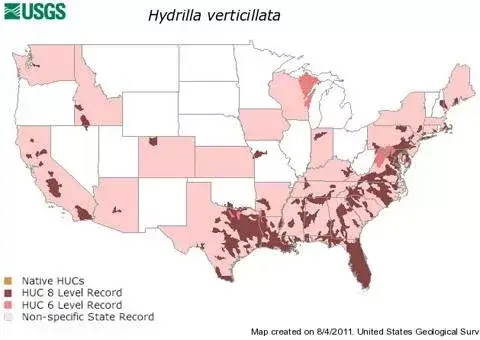

H. verticillata was detected in the Cayuga Lake Inlet in Ithaca, New York in 2011 by staff of the Cayuga Lake Floating Classroom. A follow-up survey by Robert L. Johnson, a former researcher with the Cornell University Department of Ecology & Evolutionary Biology, now with Racine-Johnson Aquatic Ecologists, located extensive Hydrilla populations in several areas of the Inlet. The Hydrilla appeared to be localized to the Inlet, with no evidence of the plant in Cayuga Lake proper. This was the first detection of Hydrilla in upstate New York. The risk of the plant spreading to the rest of Cayuga Lake and other regional waterbodies in the Finger Lakes region is considered to be substantial. State, regional, and local officials and organizations, along with biologists from Cornell University are developing plans to control, manage, and prevent the spread of the invader, as well as outreach efforts to enlist the public’s help in preventing the plant’s spread.
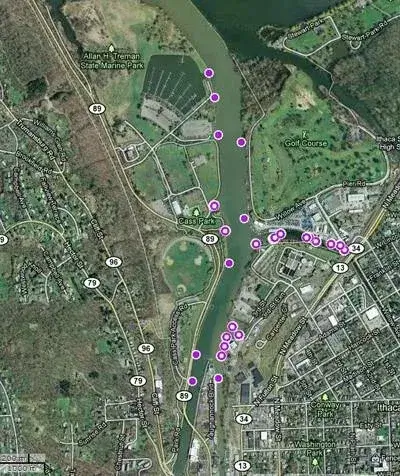
This map shows confirmed observations (green points) submitted to the NYS Invasive Species Database. Absence of data does not necessarily mean absence of the species at that site, but that it has not been reported there. For more information, please visit iMapInvasives.
